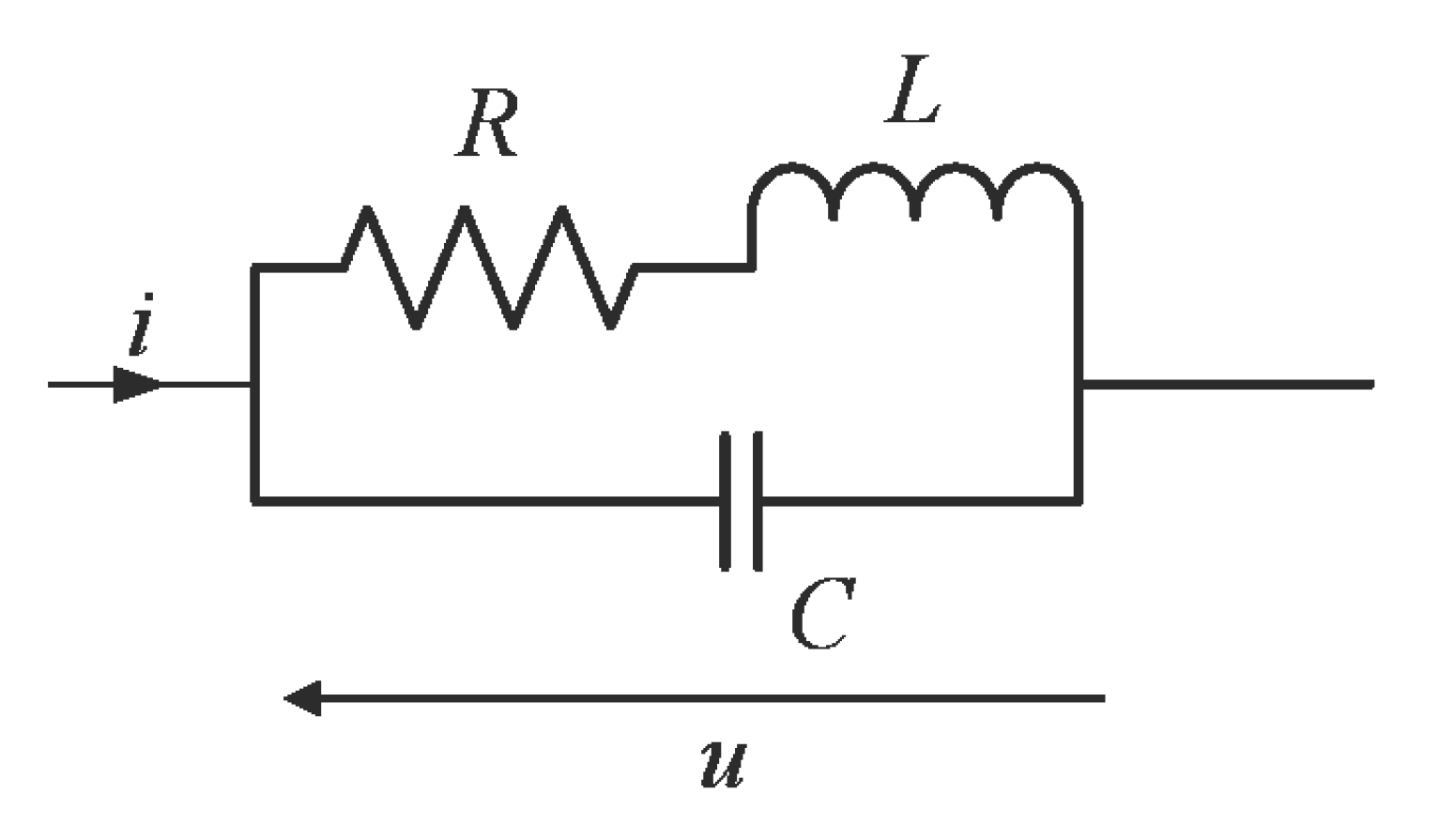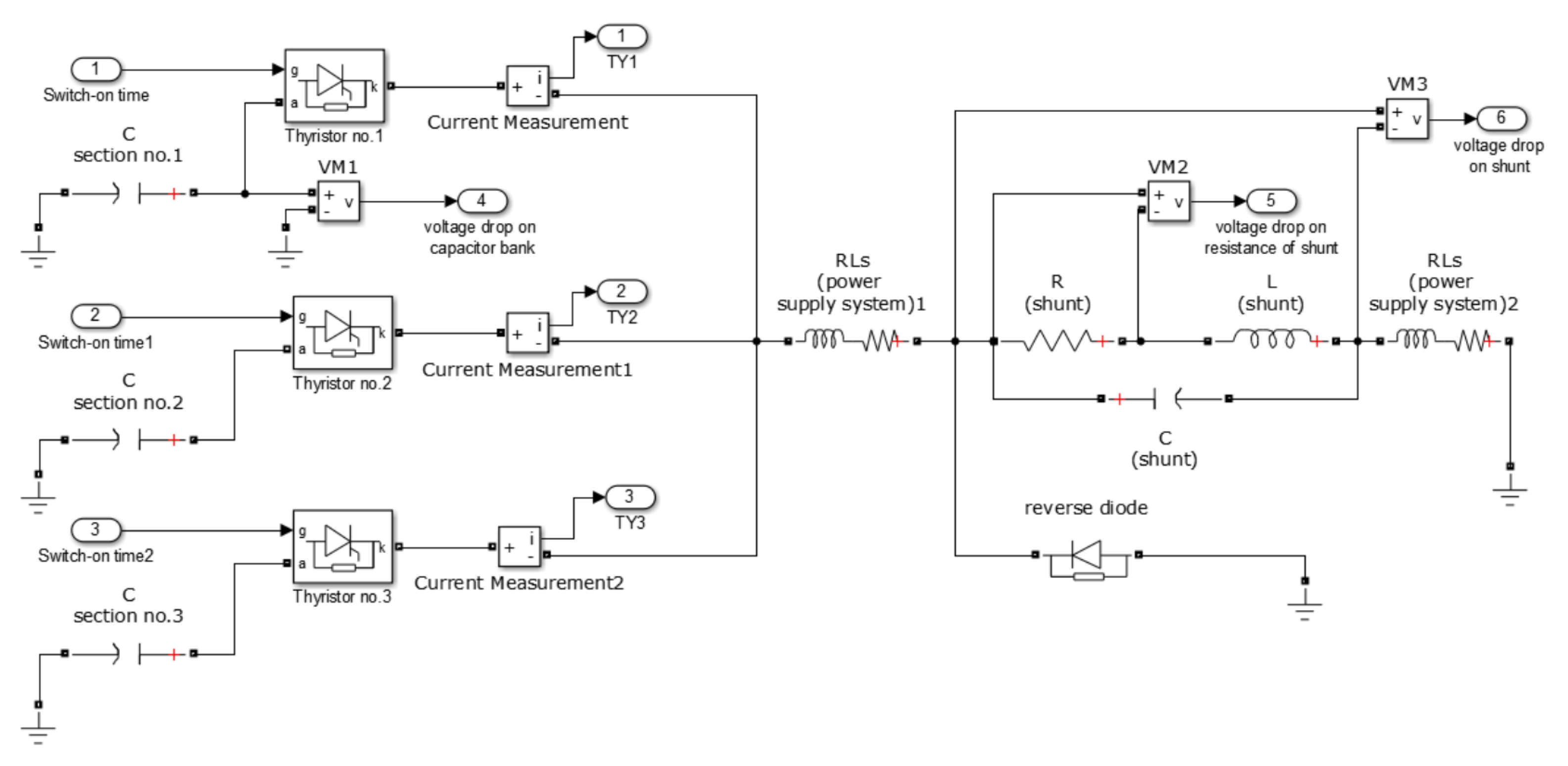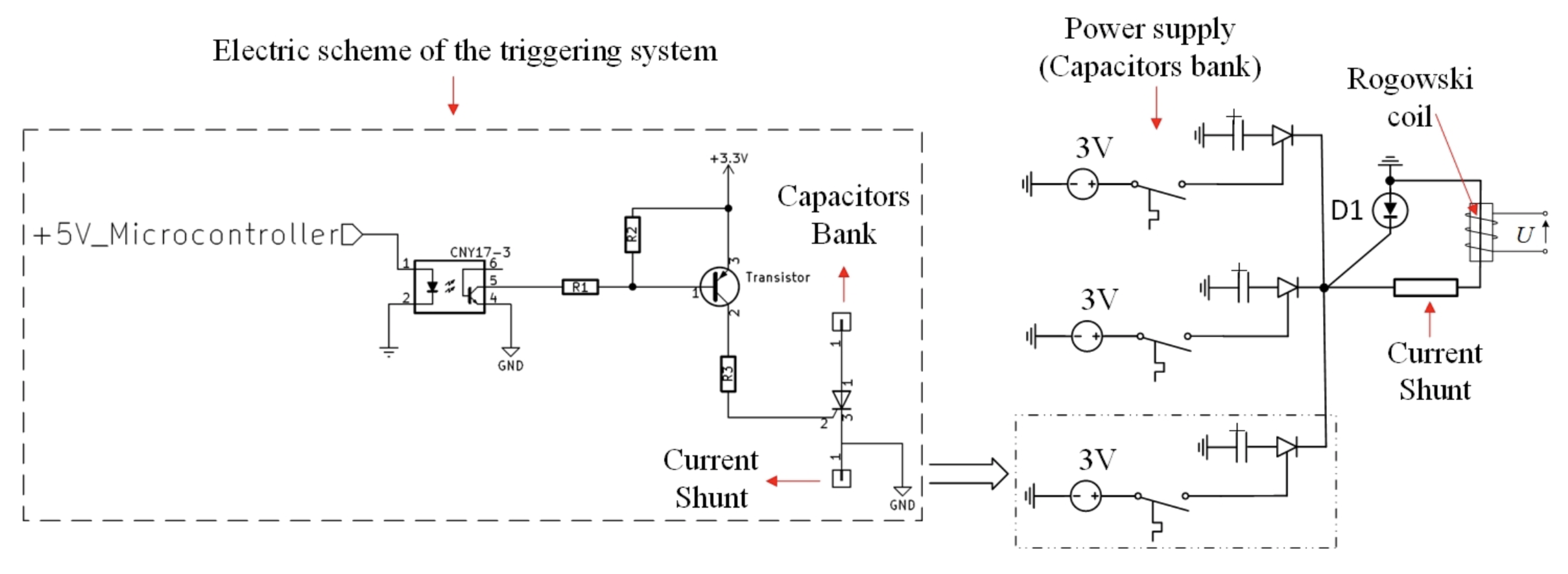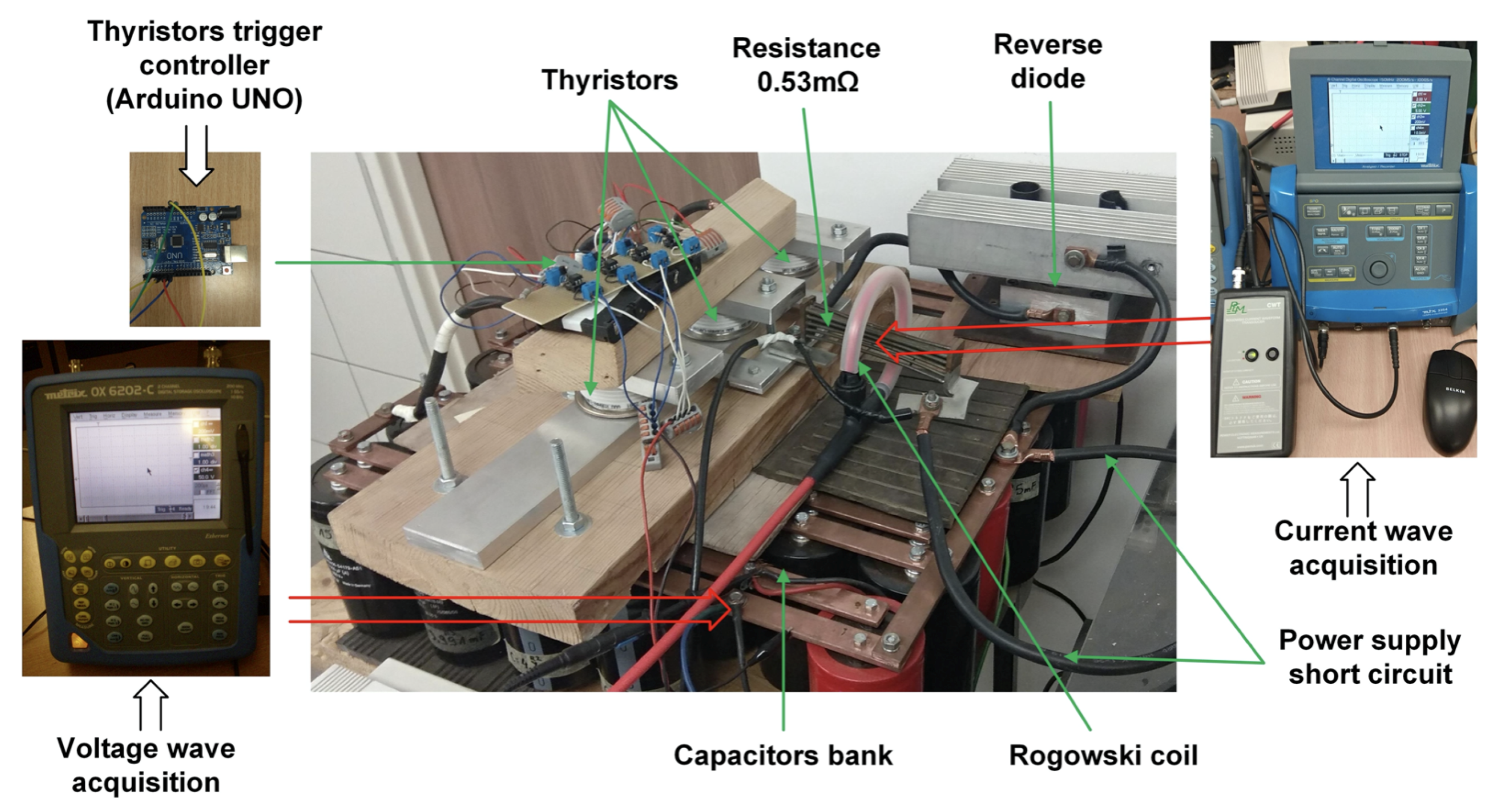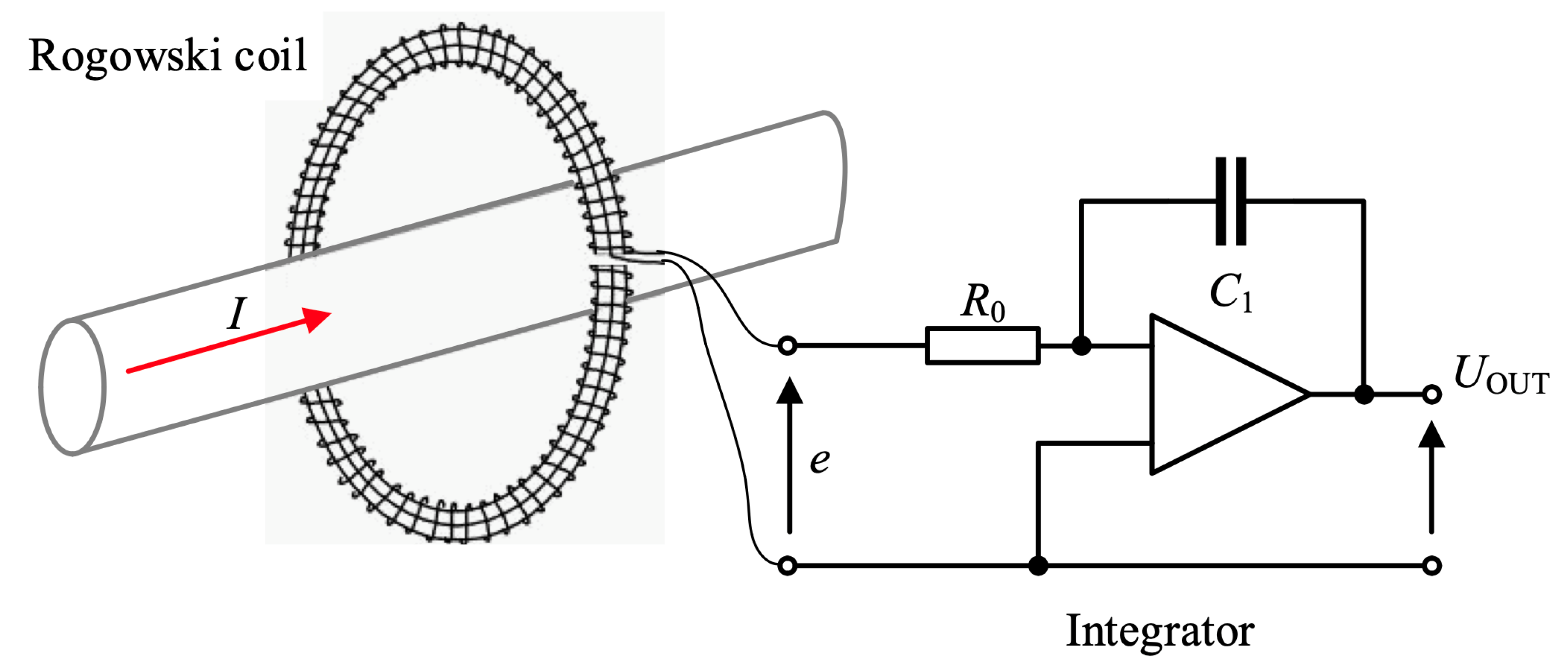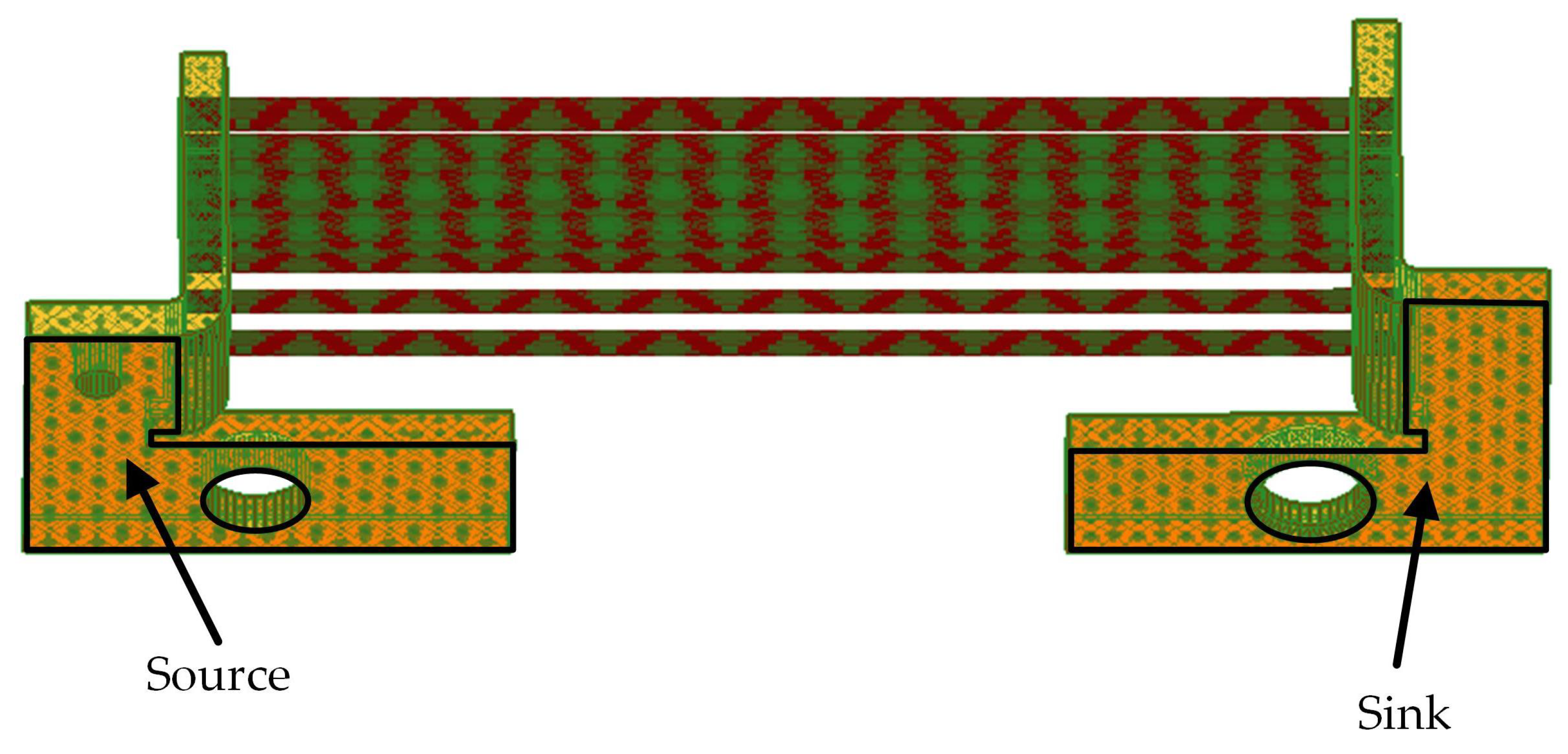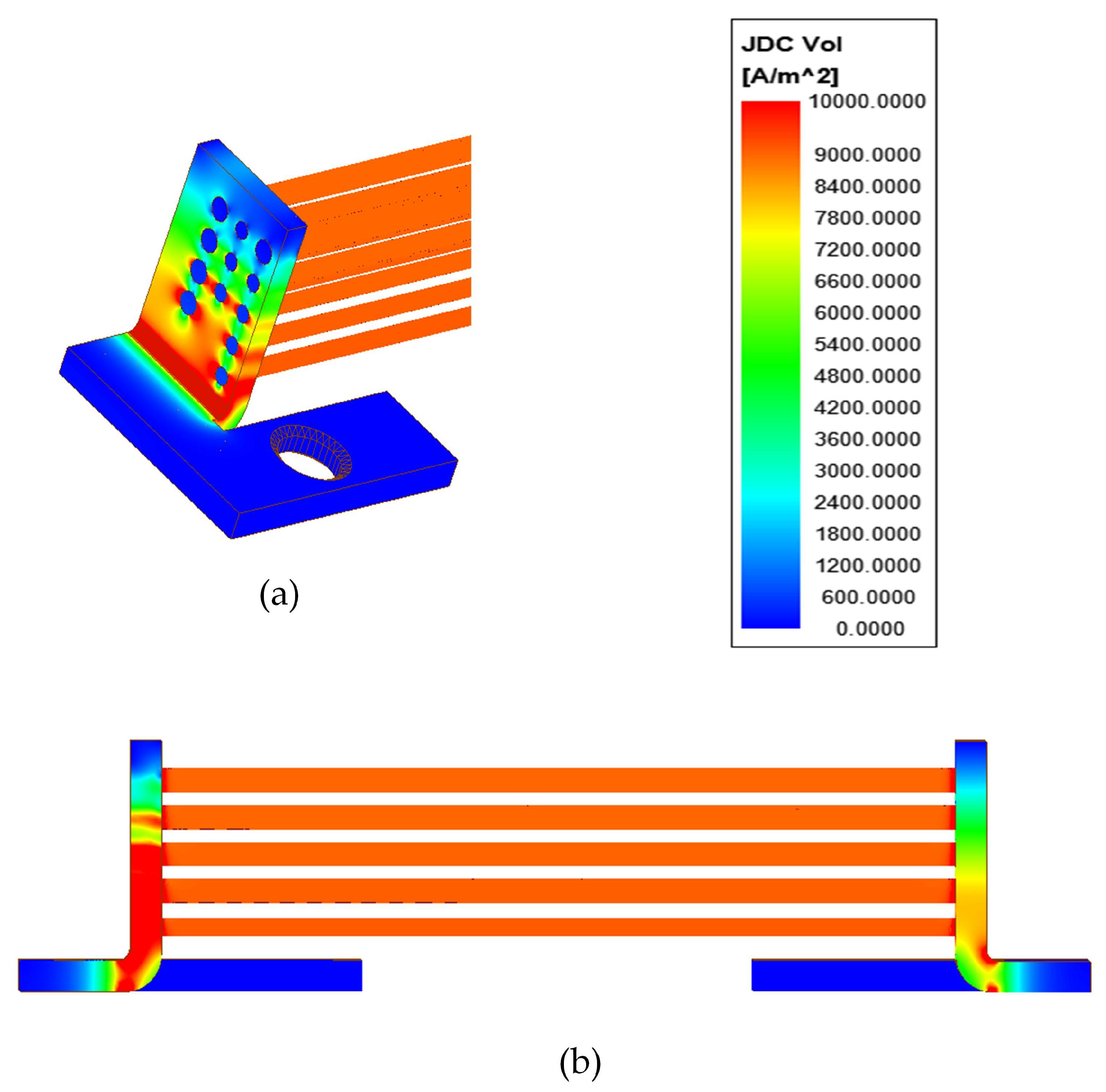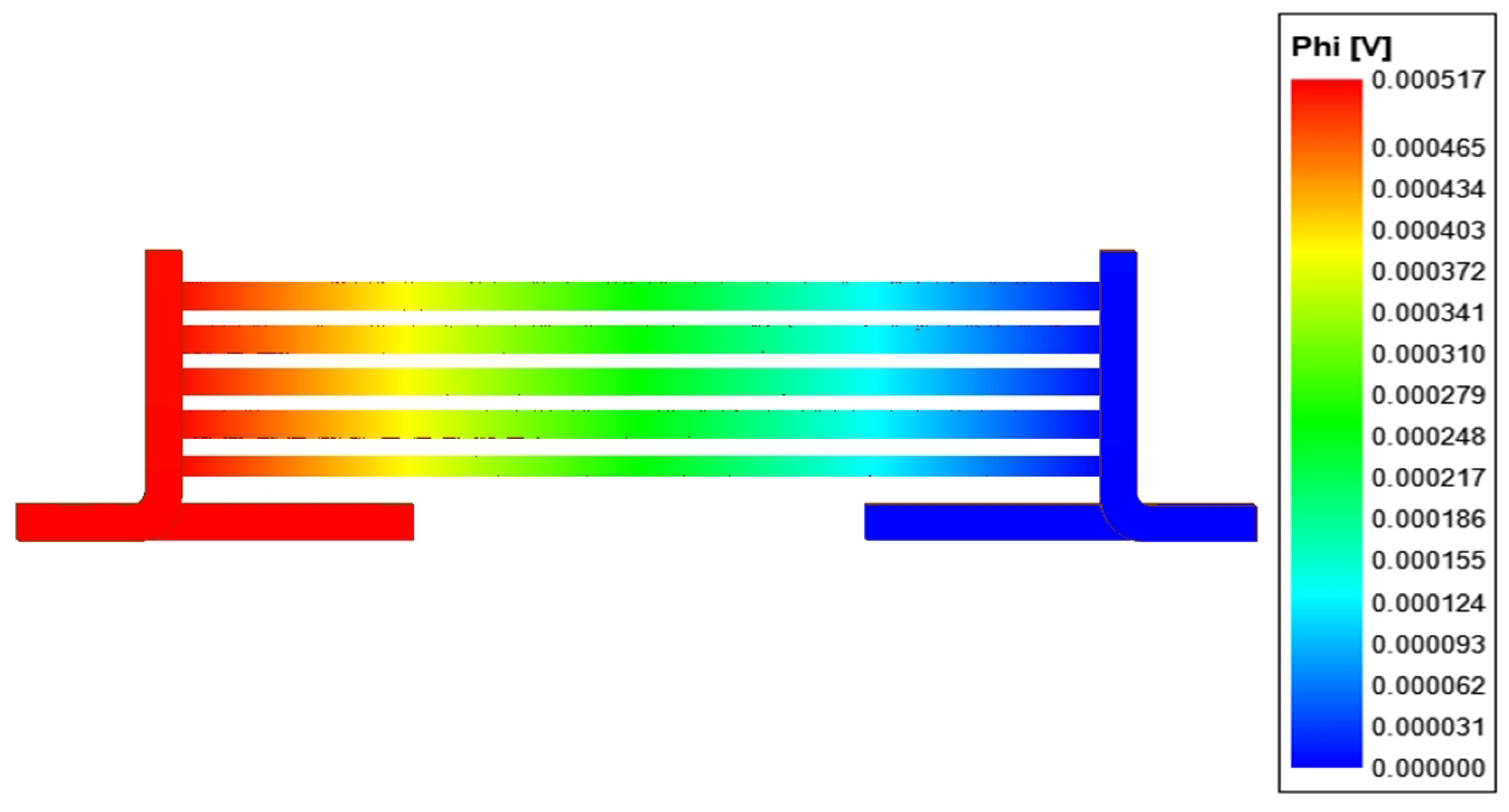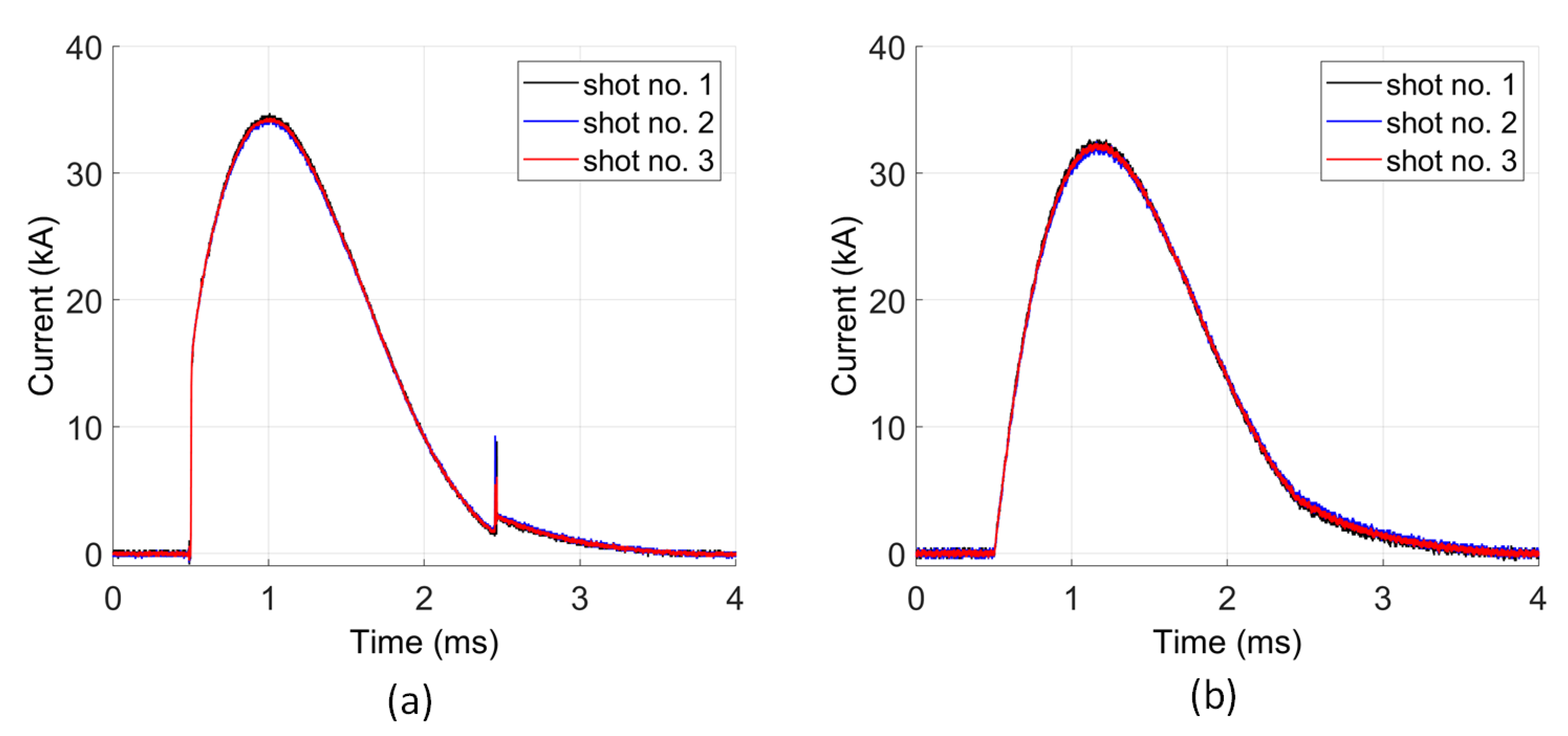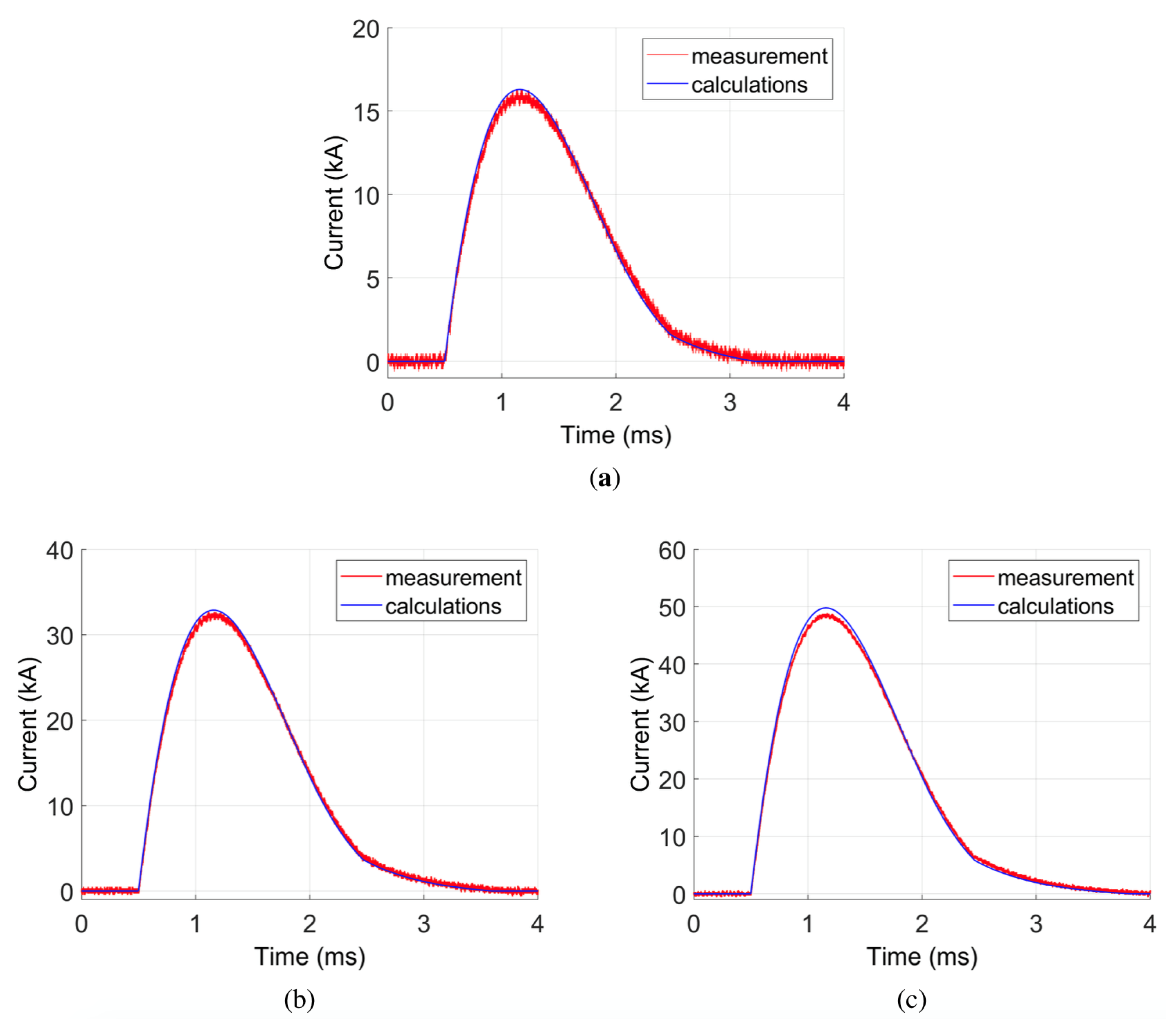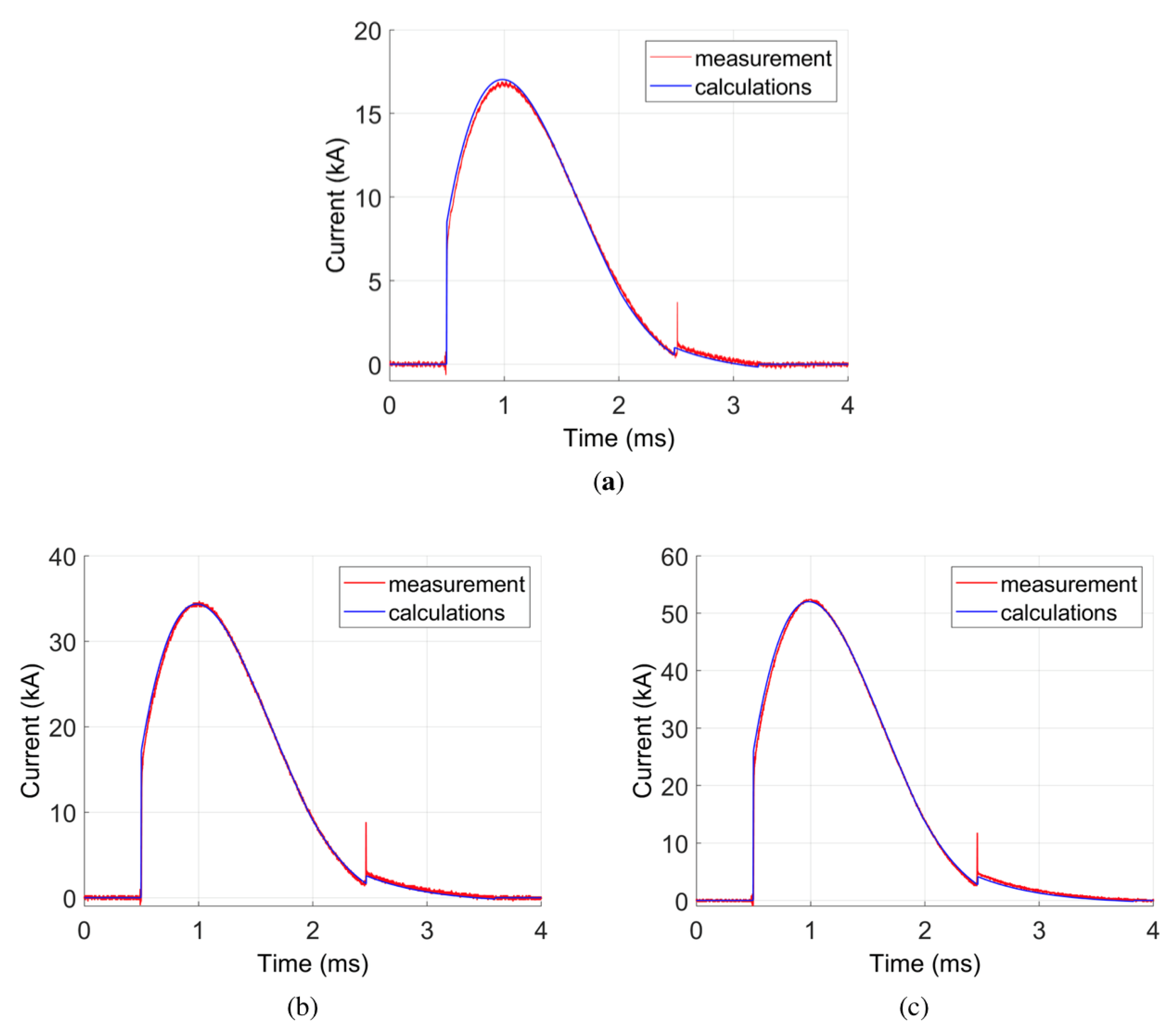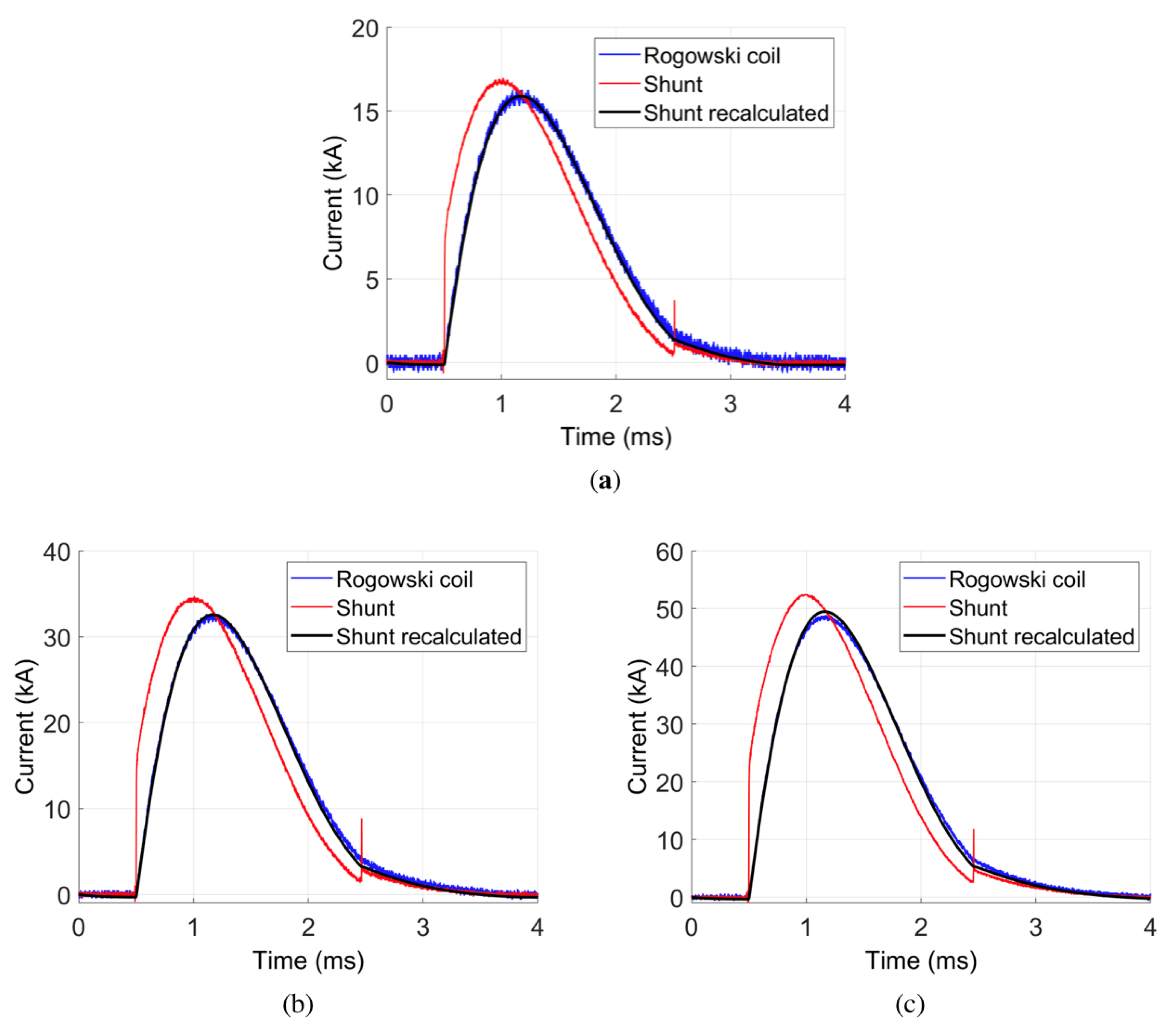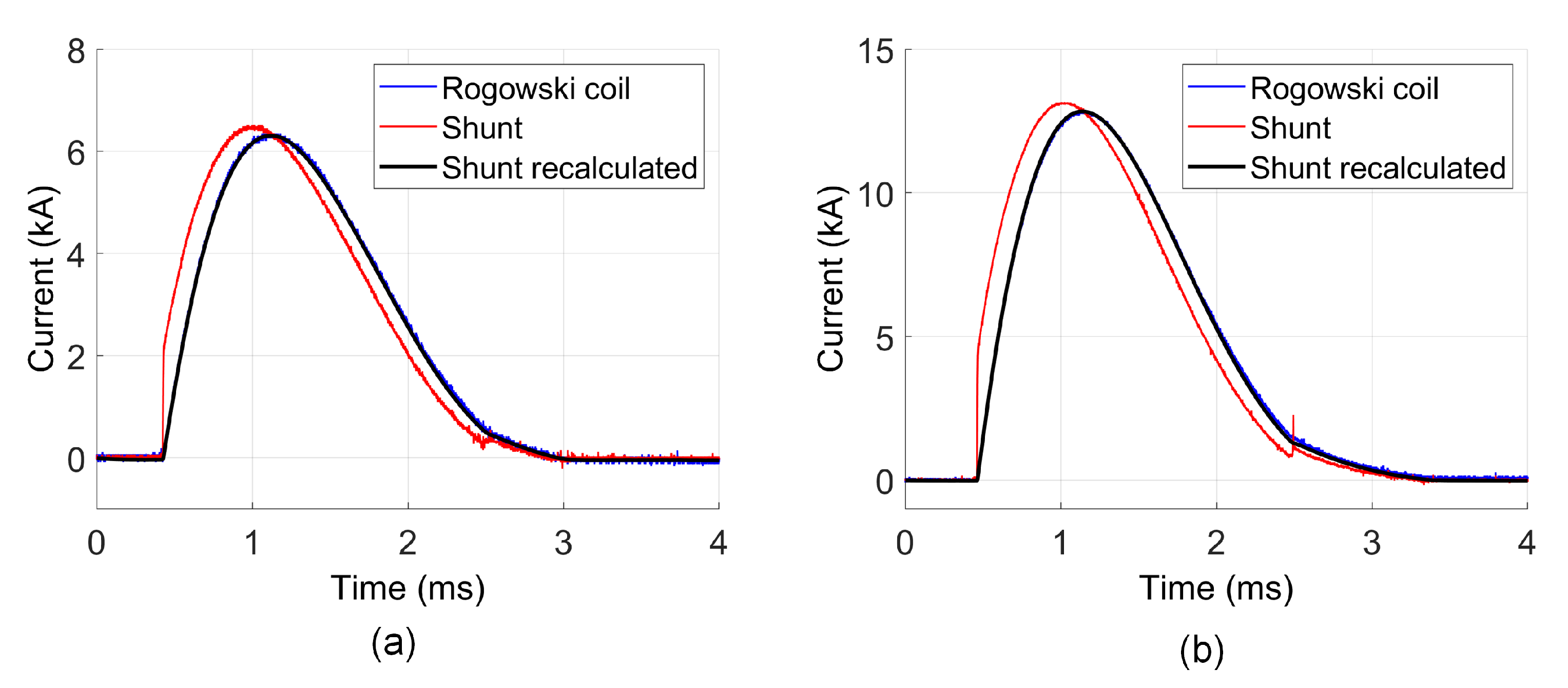1. Introduction
Design or optimization of electrical devices requires formulation of the correct mathematical model. Thus, an important step in the research is the measurement verification of the obtained results [
1,
2]. Measurements of excitation current for electrodynamic accelerators and devices powered by short-term current pulses for some milliseconds (or shorter) with an amplitude of kA to even MA are difficult due to the high dynamics of the waveform [
3,
4]. For current measurements with a peak value of hundreds of kA, current shunts and Rogowski coils are mainly used [
5]. However, using shunts for current measurement involves intrusion in the circuit. In cases of measurements in circuits with very low resistance (power supply systems for EA), the ratio of shunt and circuit resistance is relatively high [
1].
Measuring shunts enable precise measurement of the peak value and shape of the waveform of relatively fast current pulses. Current shunts are characterized by a wide frequency response, short rise time, and high accuracy of resistance values—they are made in the accuracy class from
to
. Below the upper frequency limit (
dB), the measuring shunts behave like typical DC resistors with a frequency-independent resistance value. Depending on the design used, they may be insensitive to electromagnetic interference. The design of shunts allows the dissipation of relatively high power. The voltage drop across the shunt is proportional to the flowing current. The shunt has a low value of passive parasitic components, i.e., a low value of capacitance and inductance. These parameters are particularly reduced in shunts adapted to alternating currents (ACs). As a result, in practice, capacity and inductance do not affect the quality of measurements in the range from constant signals to signals with a frequency of several kHz [
5,
6,
7,
8,
9]. For these reasons, manufacturers provide only the resistance value of the shunt. The coaxial shunt resistors are characterized by a relatively large parasitic inductance compared to the wire constructions (which are used in the presented research) [
10]. Various mathematical models of current shunts were analyzed and some tests were conducted to determine their full parameters. In [
11], the equivalent inductance of the cagelike shunts was measured against a set of four-terminal resistors. In [
12], a simulated annealing algorithm was used in order to obtain the LCR parameters, which minimize the mean squared error across different model schemes and real measurements. In both publications, the measurements are the base for the inductance determination. None of the mentioned publications deal with the problem of eliminating the measurement error, arising due to the parasitic inductance of the shunt in the case of high-current pulses. The publications are fixed on the determination of shunt parameters.
There are many different works about Rogowski coils. Current measurements of them can be influenced by many factors ranging from their construction, the shape of the coil loop, and the location of the measured circuit in the coil loop [
13,
14,
15]. Accurate calibration methods have been developed for Rogowski coils dedicated to pulsed power systems [
16,
17]. Precise calibration allows for obtaining more accurate measurement results. Traditional electromagnetic current sensors cannot accurately measure high-amplitude currents, which is due to the problem of saturation of the magnetic core. In the case of Rogowski coils, this problem does not occur because the flexible core of the coil is made of nonferromagnetic materials, and its turns are evenly wound on this core. Rogowski coils are used for noninvasive current measurement when other measuring methods, such as current shunts or current transformers, are impracticable. Due to their noninvasiveness, Rogowski coils are widely used in diagnostics [
18,
19,
20,
21,
22]. They are devoted for measuring alternating currents in the range from several hundred mA to several hundred kA and frequencies from tenths of Hz to several MHz. The output voltage from the coil is proportional to the rate of current change [
23]. Thus, in our investigations, the Rogowski coil was used as a referee for the calculation results and shunt measurements.
In the presented paper, a comparison of both measuring methods for high-current pulses occurring in electrodynamic accelerators (EA) was carried out. A problem was observed with the shape of a current wave measured by the shunt—there was a relatively high step of current value, which is not typical for an RL load. This step in the current wave is not visible in the model of the system and in measurements using the Rogowski coil. Including the small inductance of the shunt in the mathematical model, the same sharp increase was observed. Based on theoretical and experimental investigations, a method for solving this problem was proposed. It uses a circuit model of the shunt in order to obtain the proper current wave based on the solution of an ordinary differential equation (ODE). The presented method corrects the aberration of the shunt reading caused by its inductance. The correction significantly improves the accuracy of the current wave measurement, which was shown in
Section 7 and
Section 8.
2. Mathematical Model of the Current Shunt
The mathematical model of the investigated current shunt is based on its simplified equivalent circuit presented in
Figure 1. The voltage drop on the shunt is determined based on the following ordinary differential equation (ODE):
The circuit parameters of the model could be determined either by calculation or measurement methods. To determine parasitic parameters by calculations, it is necessary to use electromagnetic field simulation tools, such as ANSYS Maxwell 3D, FEMM, or Opera 3D, which are based on finite element analysis (FEA) techniques to solve the Maxwell differential field equations. However, when the geometry of the test object becomes more complex, full-field simulation is computationally intensive, the models themselves often show poor convergence, and results can be affected by significant errors. The Partial Equivalent Circuit Method (PEEC), which uses Maxwell’s integral equations instead of differential equations and analytically calculates inductance and capacitance based on geometry and material information, is a very common solution [
24,
25,
26]. Such a reduced model can significantly reduce the simulation cost. Therefore, the PEEC method is suitable for simulating high-level objects or in cases where large numbers of design iterations are involved [
24,
25,
26].
Due to the very small value of the shunt passive inductance and capacitance, and due to complex geometry of the current shunt, they were determined using a mathematical model formulated in the ANSYS Q3D Extractor program. It is a tool dedicated for calculating parasitic parameters in any 2D or 3D objects. The software allows calculating RLCG parameters (resistance, inductance, capacity, and conductivity) depending on the given frequency [
27]. Q3D Extractor uses the method of moments (integral equations), partial element equivalent circuits (PEEC) method, and finite element method (FEM) to compute capacitive, conductance, inductance, and resistance matrices. It uses the fast multipole method (FMM) to accelerate the solution of integral equations efficiently. The PEEC method requires only geometric and material information. Q3D Extractor computes the full electromagnetic field pattern using the specified mesh and the electrical parameters from the computed field quantities. To include the skin and proximity effects, a nonuniform current distribution is realized by creating a series of layers and gradings based on the skin depth [
28].
For numerical calculations of the power supply system dynamics, the circuit method was used [
29,
30,
31,
32]. The circuit model of the shunt was implemented in Matlab/Simulink software. Additionally, in order to compare the calculation results with measurement results, the power supply system was also modeled. The completed circuit model in Simulink is presented in
Figure 2.
Due to the relatively small pulse spectrum (less than 1 kHz), the capacitance value was neglected. Thus, the ODE could be written in a more simple form,
The knowledge of the shunt parameters allows for recovering the real current waveform based on the Equation (
2). Knowing the voltage wave, a current wave could be obtained by integrating the above equation. In our investigations, we implemented a simple Euler method:
where
—current value in k-th step;
—voltage value on the shunt at k-th step;
h—integration step equal to the sampling time.
Due to its simplicity, the method allows us to determine the real current wave in real-time.
The Rogowski coil was chosen as a referee for current wave measurement. It is characterized by high bandwidth and precision. The measurements were also compared with the calculation results of the shunt model and supply system. In order to compare the measurement results quantitatively, the normalized root mean square error (NRMSE) was used. It is described by the following equation [
33]:
where
N—number of measurement points;
—measured value in ith point;
—calculated value in ith point.
3. Experimental Setup
Comparative analysis of the measurement methods was carried out using the real impulse power supply system of EA. As an energy source, a capacitor bank divided into three symmetric sections with a total capacity of 363 mF was used (
Figure 3 and
Figure 4).
For switching-on of each section, high-power thyristors were implemented (model T95-1900 from Kubara LAMINA Company) [
34]. Both voltage waves on the capacitor bank and current wave were measured using oscilloscopes. The current was measured simultaneously using a Rogowski coil and current shunt. Thus, the comparison of measurement results was possible.
The electric diagram of the test stand is presented in
Figure 3. The reverse diode (D1) between the thyristor and the ground of the capacitors’ bank is used to prevent capacitors charging in the negative direction. Due to the high current value, three thyristors were used for switching on. The signals from both measuring systems were recorded on the same oscilloscope. The tests started with switching on the thyristors. The capacitor discharged through the short circuit. The thyristors switched off after discharging of capacitors, and the current flowed through the reverse diode D1.
5. Comparison of Measurement Results Obtained from Rogowski Coil and Current Shunt
In the first step to compare the waveforms from the Rogowski coil and the current shunt, measurement repeatability was tested. In
Figure 10, the waveforms of the currents from the Rogowski coil (
Figure 10b) and current shunt (
Figure 10a) are presented. The triggering of the impulse supply system was set to be the same for all waves. There are only very small differences in the recorded waveforms observed, which result directly from the fluctuation of the pulse trigger voltage. The RMS error is equal to
kA in case of the shunt and
kA in case of the Rogowski coil measurements, which is less than
of the maximum current value. This means that the waveforms obtained from both measurement methods are repeatable. Thus, a comparison of them could be made.
In
Figure 11a–c, a comparison of current waveforms obtained from the Rogowski coil and the current shunt measurements for different values of the initial supply voltage is presented. Independent of the voltage value, the current waveforms for a given measuring method have the same shape—they differ only in the maximum value, which results directly from the initial supply voltage.
The measured current waveforms differ depending on the measurement method used. In the case of a current shunt, there is a more rapid slope of current increase, and hence higher amplitudes in relation to the Rogowski coil were observed. The short pulse, observed in the shunt measurement at
ms, is arising due the voltage pulse generated on its inductance due to the rapid current change. It does not cause any current flow, thus, it is not visible in the Rogowski coil measurement. The measurement using a current shunt is more sensitive to overvoltages associated with the commutation of semiconductor elements of the power supply system. Due to the finite inductance value of the circuit, the current wave measured by the current shunt is not proper. The current cannot increase abruptly. The problem arises due to the nonzero parasitic inductance of the shunt (
Table 2).
In
Figure 11d, the waveforms of voltage drop on the capacitor battery for the subsequent series of measurements are presented. The capacitor bank is negatively charged, despite the reverse diode. The negative voltage value is higher for higher current pulses. It is due to the finite reverse time of the diode. The voltage waves cross the zero value at the same time:
ms. This means that the discharge time does not depend on the supply voltage.
The values of NRMSE for the waveforms presented in
Figure 11 are given in
Table 3. There is a significant error value observed (approximately
). The value increases along with the initial voltage value. In the case of a railgun, the driving force depends directly on the current value. Thus, in order to investigate such a device, it is important to determine the real current wave. In case of the shunt, the measurement error is too large to be credible.
6. Measurement Verification of the Current Shunt Mathematical Model
The mathematical model presented in chapter 2 was verified experimentally. In
Table 4 and
Table 5, measured parameters of the power supply system and thyristors are presented.
In
Figure 12, the comparison between Rogowski coil measurement and the calculation model for the current wave is presented. Different values of initial capacitor voltage were assumed: 50 V, 98 V, and 147 V. Remaining initial conditions were assumed to be zero. A good conformance is observed. Some differences occur, mainly for the amplitude of the measured signal. The NRMSE error between measurements and calculations is between
and
(
Table 6), which is a low value. This proves the quality of the calculation model and confirms that the Rogowski coil measures the real current wave in the system. The differences are mainly due to some simplification of the mathematical model, e.g., the eddy currents in the wires were neglected. Additionally, the measured system parameters could slightly differ from the real ones, which influences the calculation results.
A similar comparison between the model and measurement results is presented for the current shunt (
Figure 13). In this case, the voltage waves (voltage drop on the shunt) obtained both from calculations and measurements were converted to current waves. In this test, the current shunt resistance value R was determined experimentally, while the inductance value L was chosen to best fit the current shape in calculation and measurement results (
Table 7). The resistance and inductance values are very close to that obtained by the ANSYS Q3D Extractor model (
Table 2), which confirms its correctness. The capacitance was assumed equal to zero, since it does not influence the results significantly.
Taking into account the shunt inductance, a very good agreement between calculations and measurement results was obtained (
Figure 13). The NRMSE error between current waves obtained from the mathematical and physical model of the shunt is in between
and
(
Table 8). The error value is slightly higher than for the Rogowski coil model, which may be due to the sensitivity of the method to overvoltages. The results confirm correctness of the transient mathematical model. Slight differences between measurements and calculations are, similarly as in the case of Rogowski coil, due to some simplification of the mathematical model.
Comparing current waves obtained from the Rogowski coil and current shunt, a significant difference is visible (
Figure 12 and
Figure 13). Based on the mathematical model, it is assumed that the Rogowski coil measures the real current waveform in the system. In the case of high-current peaks, the current shunt does not give the proper current wave shape. This is due to its parasitic inductance. Although it is relatively small (80 nH), in the case of high-current pulses, it influences results considerably, which is visible both in measurements and numerical models. Two current steps observed in the current wave (at
ms and
ms) are due to this inductance. The first step at
ms occurs after switching on the circuit (a voltage is induced according to the electromotive force
). The second step is due to diode commutation. The electromotive force induced on the shunt inductance practically does not cause any current flow in the circuit. Thus, these peaks are not visible in the Rogowski coil measurement.
7. Recovering a Real Current Waveform from Shunt Voltage Measurement
The expression (
3) for recovering the current waveform is very simple and could be implemented in real-time applications. In the presented investigations, it was implemented in Simulink software. As the input, the voltage wave measured on the current shunt was used. The results obtained using the expression (
3) are shown in
Figure 14 (black line, Shunt recalculated). For lower voltage values (below 100 V,
Figure 14a,b), there is almost no visible difference between the current waves obtained from Rogowski coil and from shunt after applying Equation (
3). For higher voltages, only a slight difference is observed (
Figure 14c), which could be due to errors in shunt parameters determination. In
Table 9, current peak values measured by investigated methods are given.
The Rogowski coil measurement was assumed as a referee. The values obtained from the shunt after implementing our method are characterized by a significantly lower error than those obtained directly from the voltage drop measurement (red line, Shunt). The NRMSE error for waveforms obtained after applying Equation (
3) is between
and
(
Table 10). The error is relatively low, which satisfies the presented method. Thus, knowing all shunt parameters allows for obtaining the correct wave of the current, even for high-value current pulses.
The most important advantage of the presented method is its simplicity. The only problem is determining the inductance of the current shunt (the resistance is known). This could be done either by measurements or by magnetostatic field calculations using the finite element method (FEM). In the case of the field modeling, all dimensions of the shunt and all material properties must be known.
8. Tests for a Second Current Shunt
In order to test the proposed method more deeply, calculations and measurements for a shunt, which differs from the previous one, were carried out. The outline and dimensions of it are presented in
Figure 15. Compared to first one, the shunt is characterized by a lower number of rods and smaller length. In
Table 11, the parameters of the shunt obtained from Q3D model are given. These parameters were used to recover the original current waveform. The results are presented in
Figure 16. Due to the much lower nominal current of the shunt, the tests were made for lower voltage values.
Similar to the previous measurement, the Rogowski coil results were assumed as a referee. The errors values are given in
Table 12 and
Table 13. The current peak values differ more than 2.5% between Rogowski coil and shunt measurement results. After recalculation, the differences are less than 1%. The NRMSE value decreases after correction from more than 7.5% to below 1%, which is even lower than in the tests shown in chapter 7. Thus, the presented method significantly reduces the measurement error for the current shunt.
9. Conclusions
For a high-current pulse measurement (some kA) there are very significant differences between current waveforms obtained from a shunt and visible Rogowski coil. The proper current wave is measured by the Rogowski coil, while the shunt does not give the correct result. Both mathematical models and measurements show that this is mainly due to the inductance of the shunt. The value obtained from measurements ( nH) is slightly higher than that obtained from the magnetostatic field model () and from synthesis using a circuit model (). Although the value is very small, it needs to be taken into account in the current peak measurements. The capacitance of the shunt does not influence the calculation results significantly.
From the knowledge of the shunt parameters, it is possible to recover the real current waveform. A simple Euler method used for integration of an ODE describing the RL element is sufficient to significantly improve the accuracy, which was presented for two different current shunts. The simplicity of the method allows using it in real-time calculations. Thus, the shunt could be used in the measurements of high dynamic current waves (e.g., in railguns, magnetizing devices) after applying the correction arising from Equation (
3). Taking into account the higher price of Rogowski coil, in the case of some measurements, it is more convenient to use a current shunt including the presented correction method.
In order to explain problems with the measuring of high-current pulses using a current shunt, we used both numerical models and experimental investigations. The most difficult task was choosing an appropriate model of the shunt. In the presented case, the Q3D software was successfully implemented. The presented approach is very useful and not only allows us to explain problems with current pulses measurement, but also indicates the way to solve them.
